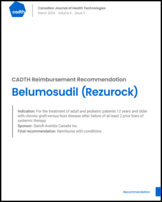|
Relevant comparators
|
| Ibrutinib has an indication for cGVHD; however, it was not submitted to CADTH for review of this specific indication and was not used as a comparator. How does ibrutinib compare to belumosudil? What is belumosudil’s place in therapy? | The clinical experts acknowledged that at this time, there was no direct or indirect evidence comparing belumosudil to ibrutinib submitted for the CADTH review. According to the experts, belumosudil would be used as per its Health Canada indication (for the treatment of patients 12 years and older with cGVHD after failure of at least 2 prior systemic therapies). They added that there would need to be good RCT evidence with appropriate comparators to support using belumosudil as an earlier line of therapy. |
|
Considerations for initiation of therapy
|
| Does it matter which 2 systemic therapies were tried first? Steroids are the mainstay of treatment; do they count as well? Does ECP (hospital procedure) count as a prior therapy? | According to the clinical experts, any 2 systemic therapies for the treatment of cGVHD (including CSs with or without a CNI and ECP) count toward the requirement of a failure of at least 2 prior systemic treatments before accessing belumosudil. |
|
Considerations for continuation or renewal of therapy
|
| How often should patients be evaluated to continue treatment? Is it every 6 months, once a year? | CDEC agreed with the clinical experts that the first authorization of belumosudil should be for 6 months with renewal for patients who have achieved an overall response (i.e., CR, PR, or stable disease with significant reduction in steroid doses), according to NIH criteria, after 24 weeks of therapy (approximately 6 months). |
|
Considerations for discontinuation of therapy
|
| What parameters should be considered to determine whether the treatment is ineffective and needs to be discontinued? | The clinical experts agreed that belumosudil should be discontinued if there is progression of cGVHD, defined as worsening of symptoms or occurrence of new symptoms. However, the experts thought that treatment for cGVHD (e.g., with belumosudil) should continue if the patient experiences recurrence or relapse of the underlying hematological malignancy and emphasized that it would be important to treat both diseases. CDEC agreed with the clinical experts that belumosudil should be discontinued if there is progression of cGVHD, defined as worsening of symptoms or occurrence of new symptoms. In addition, CDEC also recommended that belumosudil be discontinued if the dose of CS remained elevated for more than 6 weeks, or if a patient experienced more than 2 episodes of cGVHD flares that required increased CS therapy in a 6 month period of belumosudil treatment. |
| Should therapy end after a specific number of doses or after a specific number of years, or should treatment continue indefinitely as long as the patient shows a response? What number of doses is appropriate? What number of years is appropriate? | The clinical experts would not expect treatment with belumosudil to be indefinite. In their opinions, physicians would cautiously taper cGVHD treatment(s) and assess response or relapse to manage a patient’s symptoms with the minimum number of drugs and dose possible. They also noted that there is a small number of patients who remain on cGVHD treatments for life when tapering efforts fail. Due to treatment management being patient-specific, the experts were not able to define a number of doses or years that patients would continue on treatment. Additionally, in study KD025-213, belumosudil was tapered after sustained response for 6 months and cessation of all other immunosuppressants for at least 3 months. |
|
Considerations for prescribing of therapy
|
| There are several treatment options in this space. Can belumosudil be combined with other treatments? Studies used belumosudil on its own and with concomitant medications. It is unclear if treatment is intended to be alone or as adjunctive therapy. | Per studies KD025-213 and KD025-208, the clinical experts expect that belumosudil could be used alongside other treatments for cGVHD. In the studies, permitted concomitant standard of care systemic cGVHD therapies included, but were not limited to, CNIs (tacrolimus, cyclosporine), sirolimus, mycophenolate mofetil, methotrexate, rituximab, and ECP. |
|
Generalizability
|
| Can belumosudil be given to patients for whom other therapies have failed? | The clinical experts indicated that it would be possible to give belumosudil to patients if they have demonstrated intolerance to other medications for cGVHD. |
| Can belumosudil be given to patients with aGVHD? | There is currently no Health Canada indication for the use of belumosudil in the treatment of patients with aGVHD. |
|
System and economic issues
|
| Should treatment options be prioritized? | The clinical experts noted that it would be challenging to prioritize cGVHD treatments due to the lack of direct and indirect comparative evidence available for review. |
